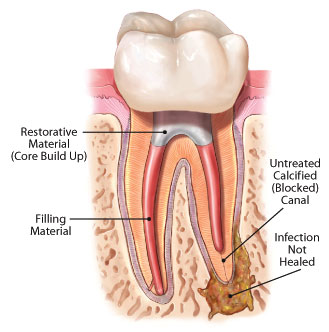
symptoms of failed root canal treatment
After a lengthy root canal treatment (RCT) Â procedure, most do ponder “How would I know whether it is a good job done?” Drifting on, our thoughts eventually go to whether the treatment has really saved our tooth. Is a root filling all you need to solve your woes?
In the first place, why do we need a root canal treatment?
A tooth is actually a living organ in the body which consist of multiple tissues. To understand the reason for a RCT treatment, one needs to have a brief knowledge on the tooth’s anatomy. The space inside a tooth is called a canal and there is pulp chamber traverses down the root towards the tip (apex). Due to injury, caries and various other factors, our tooth could be dead (devitalised) but still remain in its socket. Hence, the root canal filling is necessary to maintain tooth in its position for function.

root canal treatment

root canal treatment
When is a root canal treatment needed for your tooth?
1. Pulp involvement due to caries and injury (trauma)
2. Preparing for a crown
3. Deep fillings becomes faulty
4. Tooth became dead (non vital)
5. Relief of acute pain in particular tooth due to pus (abcess) accumulation
Is it possible to have side effects?
The success rate of every root canal treatment is actually 95%, thus leaving the remaining 5% cases with possibility of failure and the showing of symptoms. As such, it is really not accurate to refer it as side effects of RCT as not all teeth undergo treatment shows side effects except for those which failed and possibly need a retreatment. So precisely, we should refer it as symptoms of a failed root canal treatment.

Radiograph of root canal treatment

Radiograph of root canal treatment
What are the symptoms?
- Pain on the treated tooth that is excessive and does not go away with time. However, do note that there is certain post operative ache that usually accompanies the procedure.If it persists or became worst, it is not normal!
- The treatment does not resolve your initial woes. In other words there is no improvement and you still feel the pain continuously or intermittently.
- You feel sensitivity or it aches when you chew you food. Normally after an RCT the tooth may be slightly tender therefore most dentists would recommend soft foods after the treatment. If the sensitivity lingers it is a warning sign which requires attention
- Swelling or tenderness of gums around the tooth treated. Examine it frequently for any discolouration or accumulation of fluid in the gum region. Make sure there isn’t any orifice (sinus) that drains any fluid out. Inflammation means the RCT has failed and the remaining bacterial load has thrived and infects the surrounding tissues.
- The tooth became mobile and loose. Gum inflammation normally causes weakening of tooth anchoring structures.
- Presence of swelling around area of face or sinus tract infection. Not all infection could be detected early because not all present symptoms, but when it is; it may be a later stage. This is an example of one of them. Take note of your body’s signals of an inflammation if you feel fatigue, mild fever and weakness most of the time.
- Watch out for signs of re-infection in the tooth. If fluid is draining out from the treated tooth it shows that bacteria has seeps in and contaminated the sterile environment of the root filling causing re-infection.

cause of RCT failure

cause of RCT failure
Why would a root canal treatment fail?
- Number of root canals could be unexpected or overlooked during treatments as root canals can be really microscopically small.
- Hairline cracks already present in the tooth’s roots
- Shape of the root canals which sometimes have branches (accessory) canals has been overlooked in treatment.
- Certain bacteria could be resistant and not responsive to treatment
- Faulty dental filling which allows the bacteria to seep in causing recontamination of the sterile root filling.
- Tooth that is root canal treated are still susceptible to caries and gum disease if oral hygiene not performed correctly which in the end results to failure and tooth loss.
- Complications during treatment.
Now that I know it has failed what should be done?
Try to get a follow up x-ray from your dentist. The best way to confirm the root canal treatment failure is by an intra oral photography as sometimes symptoms is only suggestive but not conclusive.

Retreatment due to decay

Retreatment due to decay
What are the treatment options?
A root canal treatment which has failed usually will have to undergo re-treatment, extraction or endodontic surgery depending on case requirements.
It is always wise to maintain close communication with your dentist to identify and recognize the symptoms of a failed root canal treatment. As your dentist has been keeping your records and developments after the treatment, identification of a failure could be a breeze. If symptoms persist, don’t be alarmed but make an appointment to consult your dentist.
That was a good, informative article. Thanks!
Would you recommend seeing a root canal specialist to get a root canal re-treated or going back to a general dentist if he missed a canal the first time?
Thank you for the comment.
A re-treatment of root canal requires patience and commitment for appointments. Therefore i would recommend you go to a dentist that you trust would be able to handle your case successfully regardless a specialist or general dentist.
Your oral health is your priority, if instinct tells you the case needs more management and technique sensitivity do go to the specialist that will be able to handle it.
very consice and informative